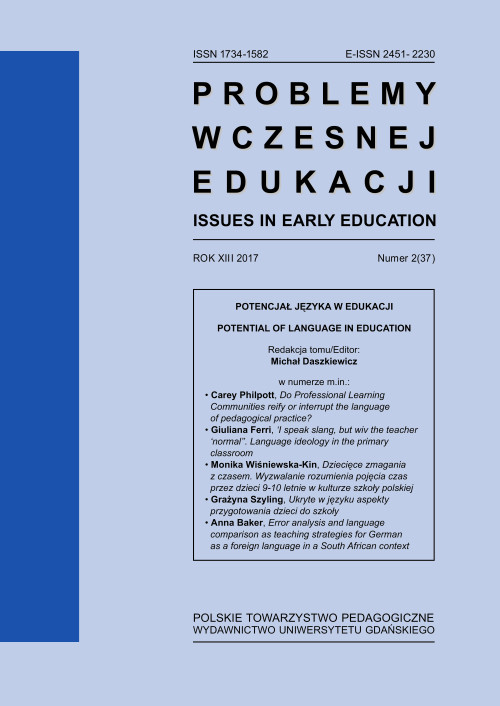Dziecięce zmagania z czasem. Wyzwalanie rozumienia pojęcia czas przez dzieci 9–10-letnie w kulturze szkoły polskiej
DOI:
https://doi.org/10.5604/01.3001.0010.5603Słowa kluczowe:
pojęcia naturalne, pojęcia matrycowe, rozumienie pojęć, strategie rozwijania dziecięcych sposobów rozumienia i interpretowania pojęć, kultura edukacjiAbstrakt
In this article, I am going to discuss the issues of triggering children’s understanding of natural concepts (on the example of the concept of time) in a cultural context. I was particularly interested in the resources provided by culture to help children understand natural concepts. In the research, I applied the basic types of procedures for collecting qualitative data: observation (observer-as-participant), interview (direct, personal, focused), documents (children’s products) and audiovisual materials (audio and video recordings). The didactic intervention activity was conducted in two second grade and two third grade classes in primary schools in metropolitan environment. The reconstruction of the children’s understanding of the concept of natural time revealed its complexity. For children there is not one time, but many dimensions of time entered in two profiles: physical time (clock) and psychological time (time of memories and perceptions). Based on my research, I see the need for triggering the cognitive activity of pupils in conditions that ensure the development of conceptual systems containing both matrix concepts and natural notions.
Downloads
Bibliografia
Anusiewicz J. (1995), Lingwistyka kulturowa. Zarys problematyki. Wrocław, Wydawnictwo Uniwersytetu Wrocławskiego.
Bartmiński J. (2007), Językowe podstawy obrazu świata. Wyd. 2, Lublin, Wydawnictwo UMCS.
Bartmiński J. (1993), O profilowaniu i profilach raz jeszcze. W: J. Bartmiński, R. Tokarski (red.), O definicjach i definiowaniu. Lublin, Wydawnictwo Uniwersytetu UMCS.
Bruner J. (2006), Kultura edukacji. Kraków, Universitas.
Casasanto D., Fotakopoulou O., Boroditsky L. (2010), Space and Time in the Child’s Mind: Evidence for a Cross-Dimensional Asymmetry. “Cognitive Science”, 34, s. 387–405.
Casasanto D., Boroditsky L. (2008), Time in the mind: Using space to think about time. Cognition”,106, s. 579–593.
Clark H.H. (1973), Space, time, semantics and the child. W: T.E. Moore (red.), Cognitive development and the acquisition of language. New York, Academic Press, s. 27–63.
De Groot-Reuvekamp M.J. i in. (2017), Primary school pupils’ performances in understanding historical time. „Education”, 3–13, Vol. 45, Issue 2, s. 227–242.
Evans V. (2004), The structure of time: Language, meaning and temporal cognition. Amsterdam, John Benjamins.
Gentner, D. (2001), Spatial metaphors in temporal reasoning. In M. Gattis (Ed.), Spacial Schemas inabstract thought, Cambridge, MA: MIT Press, s. 203–222.
Kielar-Turska M. (1989), Mowa dziecka. Słowo i tekst. Kraków, Wydawnictwo Uniwersytetu Jagiellońskiego.
Klus-Stańska D. (2007), Między wiedzą a władzą. Dziecięce uczenie się w dyskursach pedagogicznych. „Problemy Wczesnej Edukacji”, 1/2 (5/6).
Klus-Stańska D. (2010), Dydaktyka wobec chaosu pojęć i zdarzeń. Warszawa, Wydawnictwo Akademickie Żak.
Langacker R.W. (1995), Symboliczny charakter gramatyki. W: H. Kardela (red.), Wykłady z gramatyki kognitywnej. Lublin, Wydawnictwo UMCS.
Maćkiewicz J. (1996), Od chaosu do porządku, czyli o pewnym typie kategorii naukowych. W: R. Grzegorczykowa, A. Pajdzińska (red.), Językowa kategoryzacja świata. Lublin, Wydawnictwo UMCS.
Maćkiewicz J. (2000), Potoczne w naukowym – niebezpieczeństwa i korzyści. W: A. Dąbrowska, J. Anusiewicz (red.), Język a kultura. T. 13: Językowy obraz świata i kultura. Wrocław, Wydawnictwo Uniwersytetu Wrocławskiego.
Maruszewski T. (2002), Psychologia poznawcza. Sposoby rozumienia siebie i świata. Gdańsk, Gdańskie Wydawnictwo Psychologiczne.
Merritt D.J., Casasanto D., Brannon E.M. (2009), Do monkeys use space to think about time?„Society for Research in Child Development”, Denver.
Michel F., Harb F., Hidalgo M.P. (2012), The concept of time in the perception of children and adolescents. „Trends Psychiatry Psychother”, 34(1), s. 38–41.
Möhring W., Cacchione T., Bertin E. (2012), On the origin of the understanding of time, speed, and distance interrelations. „Infant Behavior and Development”, 35(1), s. 22–28.
Najder K. (1989), Reprezentacje i ich reprezentacje. Analiza podstawowych kontrowersji teoretycznych we współczesnych koncepcjach reprezentacji poznawczej. Wrocław-Warszawa-Kraków-Gdańsk-Łódź, Ossolineum.Özçalışkan Ş. (2007), Metaphors We Move By: Children’s Developing Understanding of Metaphorical Motion in Typologically Distinct Languages. „Metaphor and Symbol”, 22 (2), s. 147–168.
Piaget J. (1969), The child’s conception of time. New York, Basic Books.
Piaget J. (1970), The child’s conception of movement and speed, London, Routledge & Kegan.
Rips L., Shoben E., Smith E. (1973), Semantic distance and verification of semantic relations.„Journal of Verbal Learning and Verbal Behavior”, 12.
Rosch E. (1973), On the internal structure of perceptual and semantic categories. W: T. Moore (red.) Cognitive Development and the Acquisition of Language. New York, Academic.
Stites L.J., Özçalışkan Ş. (2013), Teasing Apart the Role of Cognitive and Verbal Factors in Children’s Early Metaphorical Abilities. „Metaphor and Symbol”, 28, 2, s. 116–129.
Trzebiński J. (1981), Twórczość a struktura pojęć. Warszawa, PWN.
Trzebiński J. (1986), Współczesne badania nad pojęciami. W: M. Goszczyńska (red.), Psychologia procesów poznawczych. Wybrane zagadnienia. Warszawa, PWN.
Trzebiński, J. (2002), Narracja jako sposób rozumienia świata. Gdańsk, Gdańskie Wydawnictwo Psychologiczne.
Wiśniewska-Kin M. (2013), Dominacja a wyzwolenie. Wczesnoszkolny dyskurs podręcznikowy i dziecięcy. Łódź, Wydawnictwo Uniwersytetu Łódzkiego.

 Uniwersyteckie Czasopisma Naukowe
Uniwersyteckie Czasopisma Naukowe





